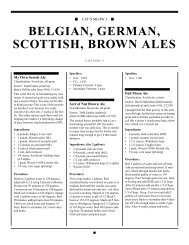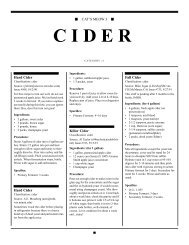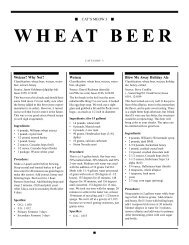STRONG BEERS - Home Brew Digest
STRONG BEERS - Home Brew Digest
STRONG BEERS - Home Brew Digest
Create successful ePaper yourself
Turn your PDF publications into a flip-book with our unique Google optimized e-Paper software.
<strong>STRONG</strong> <strong>BEERS</strong>: BARLEYWINE, OLD ALE, <strong>STRONG</strong> ALE, DOPPLEBOCK<br />
of about 1.010). Boil down to a volume of<br />
15 gallons (about 3 hours and 20 minutes.)<br />
Add 200 grams of Hallertaur pellets about<br />
2 hours into the boil. Cool and pitch yeast.<br />
Specifics:<br />
• O.G.: 1.075<br />
• F.G.: 1.022<br />
• Primary Ferment: 3 weeks at 48 degrees<br />
• Secondary Ferment: 6 weeks at 36<br />
degrees<br />
Wanking Fresh Deathbrew<br />
Classification: barleywine, all-grain<br />
Source: Richard Ransom AKA: FATHER<br />
BARLEYWINE (rransom@bchm1.<br />
aclcb.purdue.edu), Issue #732, 9/26/91<br />
Oh yes, the gravity on my last Deathbrew<br />
was about 1.063, which I consider on the<br />
light side. Very nice red color.<br />
Ingredients: (for 10 gallons)<br />
• 20 pounds, 2-row brewer’s malt,<br />
crushed<br />
• 4 pounds, 80 L. crystal malt, crushed<br />
• 5 ounces, Fuggles Leaf hops<br />
• 2 ounces, Hallertauer leaf hops<br />
• Yeast<br />
Procedure:<br />
Add crushed malt to 5 gallons water at 135<br />
degrees, stir, add a bit of near boiling water<br />
to get about 120 - 125 degree protein rest.<br />
After thirty minutes of stir-well-every-10-<br />
minutes (by the way, I use a pair of 40 quart<br />
cooler chests for mashing) add boiling<br />
water gradually (usually takes 2 gallons) to<br />
raise temperature to 155 degrees. Do this in<br />
stages...add a quart or two, stir well, stick<br />
in your thermometer, give it 5, read, add,<br />
repeat. It takes a while to equilibrate temperatures<br />
in the porridge, and you can easily<br />
bring your mash to 170 degrees (a no<br />
no) if you add too fast. Let this sit with<br />
periodic stirring for a few hours until converted.<br />
Sparge with 11 gallons of water.<br />
Collect up all that good stuff (I sparge off<br />
between 11 and 13 gallons depending on<br />
how long I want to drink while boiling) and<br />
boil roil troil and trouble. About 30 minutes<br />
before you finally tire of boiling, add 5<br />
ozs. Fuggles leaf hops. Rejoice in the<br />
aroma! Turn off the boil. Caper briefly.<br />
Add 2 oz. Hallertauer leaf hops. Cover.<br />
Cool. Pour into fermenting vessel, pitch<br />
yeast (the cake(s) from your last brew,<br />
recently stripped of their beery covering.<br />
Or be conventional, and use Whitbread Ale<br />
from the packet).<br />
[Note: Father Barleywine’s original posting<br />
is extremely detailed. We edited it down<br />
for this compilation, but you should take a<br />
look in the archives at the original if you<br />
have the time. It is time well spent. --Ed.]<br />
Specifics:<br />
• O.G.: 1.063<br />
Nightingale DoppleBock<br />
Classification: dopplebock, bock, extract<br />
Source: Mark Nightingale (night@<br />
mapme7.map.tek.com) Issue #741,<br />
10/9/91<br />
This brew is not quite as strong as a traditional<br />
dopplebock. However, the resulting<br />
beer was none less than excellent. It had a<br />
good shot of malt flavor (esp. the chocolate!).<br />
The head quite creamy. The hop<br />
ping was perfectly balanced. It is the<br />
smoothest homebrew I’ve ever had.<br />
Ingredients:<br />
• 7 pounds, Light Scottish Malt Extract<br />
• 1 pounds, Dry Dark Malt Extract<br />
• 1--1/2 pounds, 80L Crystal Malt<br />
• 6 ounces, Chocolate Malt<br />
• 2 ounces, Black Patent Malt<br />
• 8 ounces, Dextrin Malt<br />
• 1/4 teaspoon, brewing salts<br />
• 2 ounces, Perle Hops (bittering)<br />
alpha=7.6%<br />
• 1 ounces, Hallertauer Hops (aromatic)<br />
alpha=3.9%<br />
• 1/2 teaspoon, Gypsum<br />
• 2 packets of Red Star Lager yeast<br />
• 2/3 cup, corn sugar for priming<br />
• Water to 5 gallons<br />
Procedure:<br />
Mash crushed crystal and dextrin malts in a<br />
pan of water at 150F for 1 hour. Strain<br />
through collander into main kettle and<br />
sparge with 150F water until it runs clear.<br />
Add enough water to kettle to dissolve<br />
extracts (approx. 3 gallons). Dissolve<br />
extracts, salt and gypsum into kettle and<br />
bring to a ROLLING boil. Stir in 1/2 oz.<br />
Perle hops and boil 15 min. Stir in 1 oz.<br />
Perle Hops and boil 15 min. Stir in chocolate<br />
and black patent malts<br />
(UNCRUSHED!) and boil 15 min. Stir in<br />
1/2 oz. Perle hops and boil 15 min. Add<br />
Hallertauer hops in the last minute of the<br />
boil. Strain though a nylon meshed colander<br />
into Primary fermentor. Top up to 5 gallons<br />
with cold water. Cool wort as fast as<br />
possible. (I cooled it to 80 degrees in 9<br />
minutes.) At 80F add yeast. Ferment for 12<br />
days at 40-48 degrees. Rack it into the secondary<br />
and let it sit and ferment VERY<br />
slowly for 1 month at 32-40 degrees. Bottle<br />
and let age for a full month at 34 degrees.<br />
Specifics:<br />
• O.G.: 1.060<br />
• F.G.: 1.025<br />
• Primary Ferment: 12 days @ 40--48<br />
degrees<br />
• Secondary Ferment: 1 month at 32--40<br />
degrees<br />
Barleywine<br />
Classification: barleywine, extract<br />
Source: Ann Nelligan, (anelliga@hamlet.<br />
Prime.COM) Issue #818, 2/6/92<br />
Ingredients:<br />
• 2 cans, Munton & Fison Light Malt<br />
Extract<br />
• 2 pounds, Munton & Fison light dried<br />
malt extract<br />
• 1/4 pound, Domino light brown sugar<br />
• 3--1/2 ounces, Fuggles hops<br />
• 1/2 ounce, Fuggles for finishing<br />
• 2 packs, Munton & Fison ale yeast<br />
Procedure:<br />
We did a single stage fermentation, so I<br />
can’t answer your question about how long<br />
to age in secondary. We gave the finishing<br />
hops 10 minutes. As far as conditioning in<br />
bottles---well, it’s been 14 months now and<br />
it keeps getting better. At 2 months it was<br />
OK, but cloudy enough that we thought we<br />
should have used gypsum. It was also<br />
VERY sweet, but also very hoppy and<br />
quite smooth. By 9 months it was clear, but<br />
quite heavy and we thought maybe less<br />
sugar. Last week it had gotten considerably<br />
drier and VERY clear. It’s really good now,<br />
so I don’t know if it’ll last long enough for<br />
me to give you an update later.<br />
PAGE 135






